Of What Is The Relief Sculpture Of Assurbanipal And His Queen In The Garden A Depiction?
Miniature Museum Replicas from the Great Empires of the Ancient World (Includes Biblical Artifacts)
EMPIRES: Assyria � Babylon � Persia � Greece � Rome -- KINGDOMS: Egypt � Israel
Ancient Assyria - Ashurbanipal Feasting
Build a Fortress  Walls and Towers Assyria Biblical Biblical Biblical Biblical Biblical Biblical Biblical Biblical Biblical Biblical Biblical Biblical Biblical Biblical Biblical Biblical Biblical Biblical |
This miniature replica is of Ashurbanipal, King of Assyria, feasting in his royal garden with his queen. The bas-relief is from his palace at his ancient capital, Nineveh. His Biblical name was Asnapper. The panel was discovered at the site of ancient Nineveh during the reign of Ashurbanipal (668-626 BC). The original is located at the British Museum in London. The alabaster relief is part of a panel standing over 25 inches tall. Ezra 4:10- and the rest of the nations whom the great and noble Asnapper brought over, and set in the city of Samaria, and in the rest of the country beyond the River, and so forth, wrote. Museum Images Information about the Ashurbanipal Feasting Relief - Limestone relief from the N. palace of Ashurbanipal at Nineveh, his capital. As one scholar eloquently puts it, "The Bible mentions "the great and noble Asnappar" who is actually Ashurbanipal, the son of Esarhaddon, who succeeded his father on the throne and reigned from 669-626 BC. He was the last of the great Assyrian kings. This relief scene was carved on alabaster and depicts the king of Assyria, Ashurbanipal, reclining on a well upholstered couch. He is in the royal park, which is planted with date palms, conifers and shrubs. Vine tendrils, leaves and grapes, shade the king. He is relaxed and has laid aside his weapons, sword, bows and arrows. He is wearing a headband with streamers and an embroidered coverlet with tassels at the corners is spread over his legs. With his right hand he raises a goblet to his lips, in his left hand he holds a flower. Beside the couch is a table laid with food. Opposite him is his wife Ashursharrat in a richly decorated robe sitting on an elegant throne with a footstool. She is also drinking. Servants bring them food and other servants wave fly-whisks. In the background a musician plays a lyre with 11 strings. Not such a peaceful scene because off in the left corner a head is hanging from a tree. This head might be the king of Elam because this scene Ashurbanipal is celebrating his victory over the Elamites at the battle of Susa in 655 BC." Asshurbanipal and his wife in a vine bower. 668-626 BC. "There [is] Elam and all her multitude round about her grave, all of them slain, fallen by the sword, which are gone down uncircumcised into the nether parts of the earth, which caused their terror in the land of the living; yet have they borne their shame with them that go down to the pit." - Ezekiel 32:24 "And the rest of the nations whom the great and noble Asnappar brought over, and set in the cities of Samaria, and the rest [that are] on this side the river, and at such a time." - Ezra 4:10 *based on their recent victory over the Elamites at the Battle of the River Ulai, or of Til-Tuba. Some translations of the inscriptions on Ashurbanipal's sculptures reads: Another inscription on a sculpture of soldiers in a chariot who are carrying Te-umman's head to Assyria reads: "The head of Te-umman, king of Elam, which they had cut off in the battle in the sight of mine army as a symbol of glad tidings they carried quickly to Assyria." This panel was the focal point of a decorative scheme incorporating all the triumphs in war and sport of which King Ashurbanipal (reigned 669-631 BC) was most proud. The panel probably decorated one of the King's private apartments, as the carving of the scene is exceptionally fine. The queen sits facing Ashurbanipal. Queens, like women in general, were seldom represented in Assyrian sculpture. However, women did sometimes hold power at the Assyrian court, though usually behind the scenes. Documents suggest that Ashurbanipal's grandmother, Naqia-Zakutu, was extremely influential in promoting her son Esarhaddon and then Ashurbanipal to the throne. The scene also shows a harpist. Images of musicians are among the most important sources for understanding ancient musical instruments. The details in the carving appear to be very accurate. On the tree in front of the harpist is a human head, that once belonged to Teumman, king of Elam, who had fought against Assyria. Consequently Ashurbanipal's army invaded Elam. The campaign was illustrated as redecoration in one of the rooms of the palace of his grandfather Sennacherib (reigned 704-681 BC). The mutilation of the faces of the king and queen was probably done by an enemy soldier when the Median and Babylonian armies ransacked Nineveh in 612 BC. Dimensions The palace was excavated by H. Rassam (from 1853) British Museum Page The first great military empire in ancient history was the Assyrian Empire. By the time of Ashurnasirpal and Shalmaneser III in the 9th century BC the Assyrians organized a mighty army of nearly 200,000 soldiers. Their military strategy was unsurpassed up to that time, and with the age of iron they were an unstoppable fighting machine. They brought spearmen, archers, shieldmen, slingers, siege engines, chariots, and a huge calvary into the battlefield. The mighty Assyrians dominated the ancient world until they were crippled by the God of Israel in the reign of Sennacherib. God raised up the Assyrians to remove Israel out of his sight for their rebellion and idolatry, but the Assyrians would also be punished also for their wicked ways. They finally fell to the Medes and Babylonians in 612 BC and passed into history. 2 Kings 15:29 - In the days of Pekah king of Israel, Tiglath Pileser king of Assyria came and took Ijon, Abel Beth Maacah, Janoah, Kedesh, Hazor, Gilead, and Galilee, all the land of Naphtali; and he carried them captive to Assyria. 2 Kings 15:19 - Pul the king of Assyria came against the land, and Menahem gave Pul one thousand talents of silver, that his hand might be with him to confirm the kingdom in his hand. 2 Kings 18:9 - And it came to pass in the fourth year of king Hezekiah, which [was] the seventh year of Hoshea son of Elah king of Israel, that Shalmaneser king of Assyria came up against Samaria, and besieged it. Isaiah 20:1 - In the year that Tartan came unto Ashdod, when Sargon the king of Assyria sent him,) and fought against Ashdod, and took it; 2 Kings 19:16 - LORD, bow down thine ear, and hear: open, LORD, thine eyes, and see: and hear the words of Sennacherib , which hath sent him to reproach the living God. 2 Kings 19:37 - And it came to pass, as he was worshipping in the house of Nisroch his god, that Adrammelech and Sharezer his sons smote him with the sword: and they escaped into the land of Armenia. And Esarhaddon his son reigned in his stead. Ezra 4:10- and the rest of the nations whom the great and noble Asnapper brought over, and set in the city of Samaria, and in the rest of the country beyond the River, and so forth, wrote. Assyrian Kings Names in Cuneiform Archaeology of Ancient Assyria Timeline of Ancient Assyrian Kings (During the Period of the Biblical Kings) Assur-nasirpal II (885-860 B.C.) A cruel warrior king, he made Assyria into the most fierce fighting machine of ancient world. For More Info See: Bible History Online The Assyrian Annals. The scribes of the chief cities of the Assyrians wrote the accounts of the king's military campaigns on cuneiform tablets, and clay prisms or cylinders. The accounts are very reliable, even though the accounts do not speak negatively of the Assyrians and are meant to glorify the king. The annals also give much detail to geography and Chronology. It is interesting how accurate the Assyrians were with dates, they made use of an Assyrian Kings List or the Eponym Canon. The Assyrian Chronicles and Eponym Canon. The Assyrian scribes organized their national events whether military, political or religious every regnal year. The Babylonian Chronicles were structured the same way. Assyrian records were kept very carefully, they took their dating and their history seriously. They attached their record of events with the solar year and with the name of an official who was known as the "limmu." Their was a new limmu appointed every year. They recorded military, political and religious events in every year and made references to eclipses. The Assyrian records are highly dependable and allow Biblical scholars a very accurate way of dating events and designating "eponyms" for 244 year in Hebrew history, from 892-648 BC. The Assyrian King List. The Assyrian King List reveals a list of the kings of ancient Assyria in chronological order, from the 2nd millennium BC to 609 BC. It lists the name of the king, his father's name, the length of his reign, and some great achievements. Assyrian Sculptures. The limestone bas-reliefs discovered from the palace walls of major Assyrian capital cities like Nineveh (Kuyunjik), Nimrud (Calah), Khorsabad (Dur-Sharrukin), and the bronze bands on the Balawat Gates reveal a wealth of history. The illustrative events were carved be professional Assyrian artists like a modern day photographer on the scene. The carvings reveal the military might and tactics of the Assyrians, as well as the futility of those nations that defied their might. These sculptures are on display in museums around the world, for example: The British Museum in London, The Louvre in France, The Iraqi Museum, and The Oriental Institute in Chicago. The Bible. The Old Testament records the history of the Kingdoms of Israel and Judah, along with the battles of other nations. It includes the fall of the 10 tribes in northern kingdom of Israel in 722 BC by the Assyrians, as well as the fall of the southern kingdom of Judah in 586 BC by Nebuchadnezzar of Babylon. The Bible also records miraculous events surrounding people like Elijah, and Jonah, as well as the slaying of 185,000 Assyrians at Jerusalem by the Angel of the LORD. The events recorded in 2 Kings generally agree with Assyrian and Babylonian sources. |
Of What Is The Relief Sculpture Of Assurbanipal And His Queen In The Garden A Depiction?
Source: https://www.ancientreplicas.com/ashurbanipal-feasting.html
Posted by: darcystento.blogspot.com


































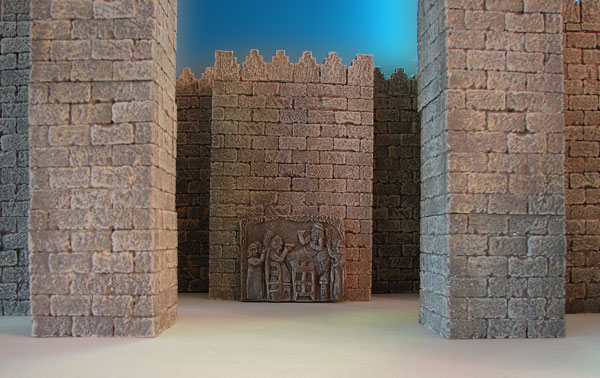

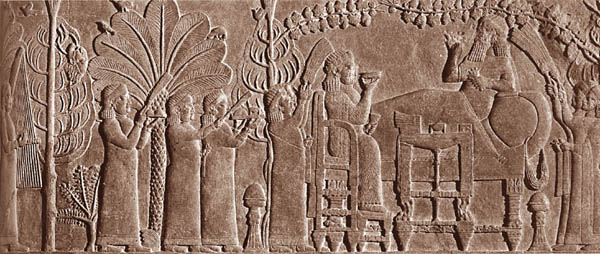
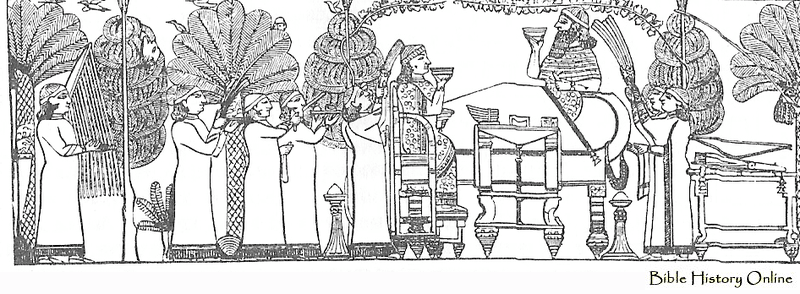
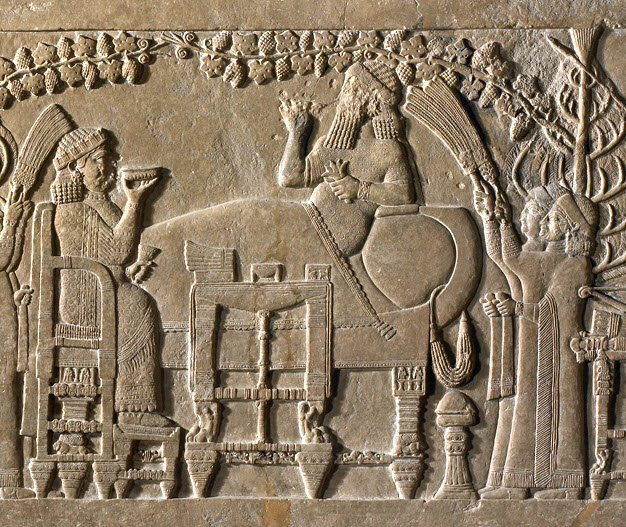


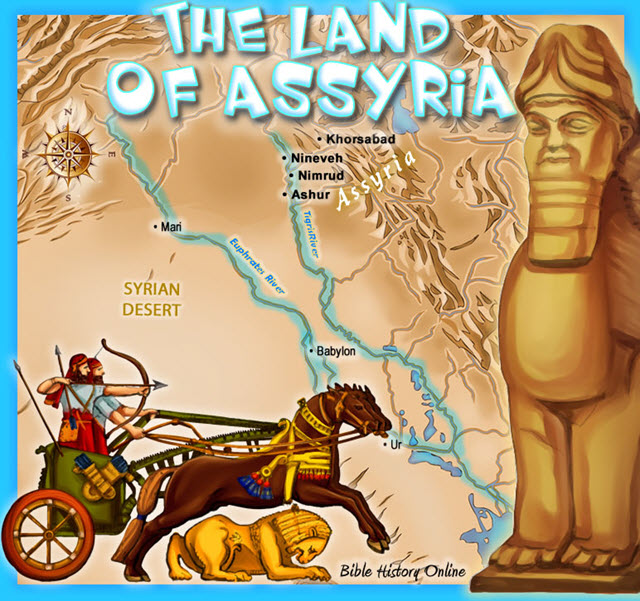
0 Response to "Of What Is The Relief Sculpture Of Assurbanipal And His Queen In The Garden A Depiction?"
Post a Comment